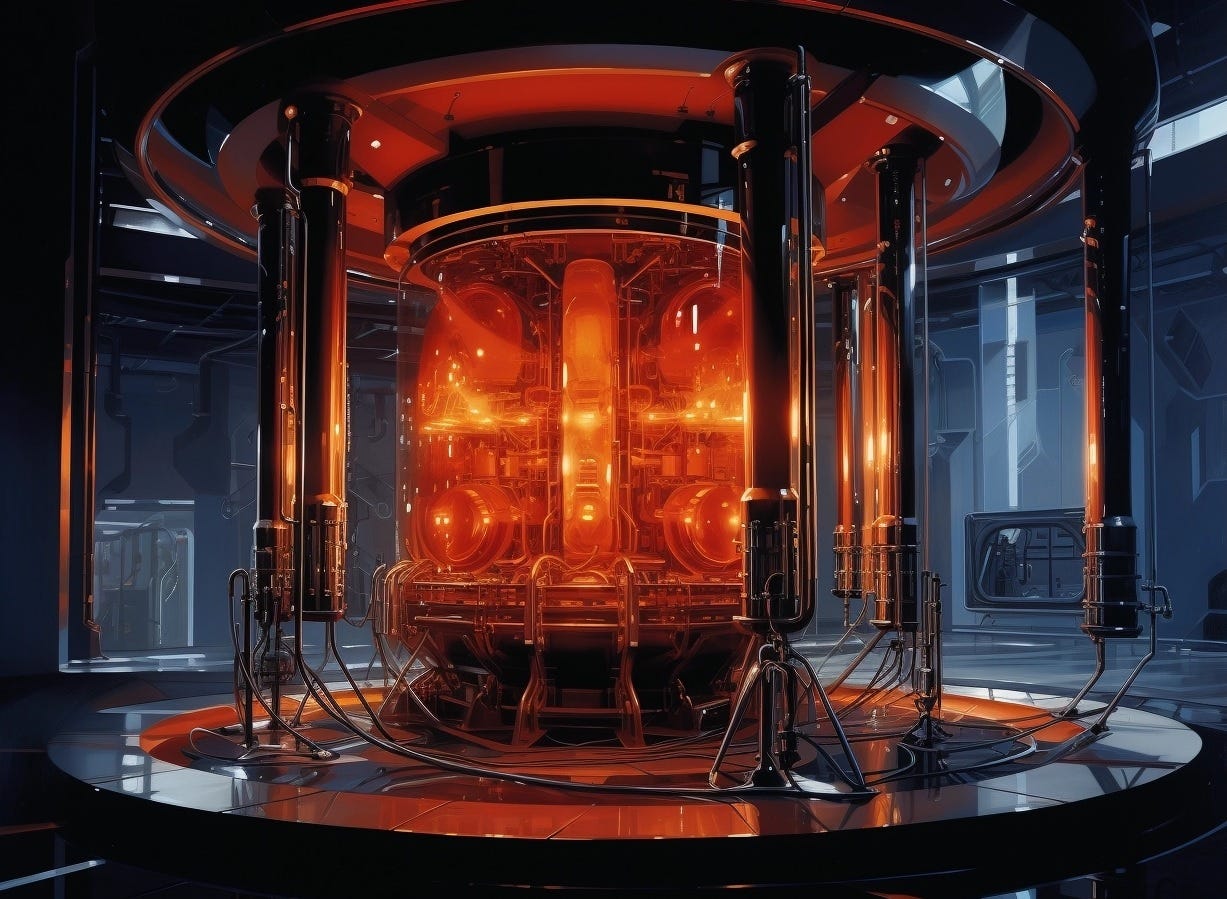Nuclear fusion holds the potential to provide the world with cheap, clean, virtually inexhaustible energy for the future. For decades, the technology was dismissed as sci-fi fantasy. But a series of recent technological breakthroughs — including a net-energy gain ignition at Lawrence Livermore National Laboratory last December — and spate of startups have made both government and investors increasingly optimistic. To talk about the state of the fusion industry, I’ve brought on Andrew Holland, chief executive officer at the Fusion Industry Association.
In This Episode
The importance of recent fusion breakthroughs (1:17)
What should policymakers be doing to promote fusion? (5:58)
Environmentalism and fusion energy (14:09)
Will fusion be the main energy source of the future? (18:57)
Below is a lightly edited transcript of our conversation
The importance of recent fusion breakthroughs
James Pethokoukis: Until recently, fusion energy was a government science project that you didn’t hear much about. But now we have dozens of startups involved and frequent media coverage of big breakthroughs. What happened?
Andrew Holland: It's results. Results, results, results. Science is progressing. Things have happened on both sides of the science of fusion. Plasma physics has been around for 60 years. It's really hard. It's really challenging. And they had to create a whole new area of physics, plasma physics, to be able to understand how to do fusion. They did that for 60 years, and it was continued short progress here and there, two steps forward, one step back. Until we got to the point probably about five or 10 years ago where the scientists said, “We think we know how to make this work.” But then what's happened is that startups and new thinking came in and applied all of the other technological advances that were out there—things like material science, artificial intelligence, machine learning, high-speed computing—as well as new business practices, putting those in effect onto what had been this kind of staid field of government science.
Putting those two together, and that's where the real developments and changes and things are happening. In fact, there are 38 members of the Fusion Industry Association now, with a few others around the world that are stragglers. And it's been just this almost Cambrian explosion of different technologies and ways forward and paths to get there. And everybody is competing to be the one to get there first and the one to get there best. So it is an exciting time. And we're seeing the effects of all of this other technology coming into plasma physics. Things have really changed.
So how significant was that breakthrough at Lawrence Livermore last year, both for the technology and also for investor and public awareness?
Yeah, it is significant in the kind of public awareness and public assessment of it. I can tell you that our website had its highest day ever in December when the announcement from the NIF happened. And I can tell you just kind of anecdotally a lot of that awareness came about. But the nature, I think, of an exponential curve, a Moore's law–type thing where it doubles every year, doubles every so often—is that when it's exponential, it's going straight up, but for a long time it looks pretty flat. So a long time below the level, it's been doubling and doubling and doubling over a number of years. It just started from a very low point. Those inside the field knew that something was happening, but it never broke out. It never got into the New York Times. It never got into Twitter discussions. It was all sort of inside baseball discussions.
It's been a completely new thing for the fusion community to now have a lot of interest coming into it. That said, though, the investors were a little keyed in a little bit earlier. Since the NIF announcement, we've seen some new deal flow. We've got about $6 billion invested in private fusion. Of that, most of it came in before the NIF announcement. Investors were looking at this. Investors were aware of it. We are still seeing some of the deal flow that post-NIF takes some time. There's a lot of due diligence that investors do and stuff like that, so we haven't yet seen the real explosion from NIF of investment and running. But I think we're due to pretty soon.
We're seeing this as kind of a starting gun of competition around the world.
What should policymakers be doing to promote fusion?
What is the policymaker awareness and action on this technology?
We're getting there. In March of 2022, the White House held an event calling for a “bold decadal vision on commercial fusion,” basically saying, can you get to commercial fusion in 10 years? It's an aggressive target. Our company said, yes, we can—with your help. The White House put in not an aggressive amount of budget in the scheme of billions and trillions even in the IRA and various other subsidy measures. Instead what they've started up is what's called a new milestone-based public-private partnership. The government gives pay-for-performance metrics on how to invest in fusion companies. Basically, the companies will say, “We think we can do this, this, and this.” And then the government says, “Okay, we'll pay you X amount for each of these milestones when you reach them.” Instead of the old way of doing a public-private partnership, which is you have to account for all the money you put in and we'll give you a fixed dollar amount and all this sort of stuff.
This is actually the way that NASA invested in SpaceX. It's a way to promote innovation in the companies while also protecting the taxpayer, because it is still risky in a business sense to put money into fusion. It's a really innovative new model for getting there. The DOE just put out these awards a couple of weeks ago in late May. It's gone to eight companies fusion companies, all doing work here in the United States.
We're seeing this as kind of a starting gun of competition around the world. The Brits have an aggressive program for a commercial fusion pilot plant. The Germans just put out a roadmap for how to get there. The Japanese have one. For a long time, the government science people have been cooperating together at ITER, which is the publicly funded science experiment in the south of France. It will get net energy when it turns on, and will be a significant experiment, but it's different than a commercial direction. And now we see all these countries and companies racing towards this. And honestly, we also see the Chinese making aggressive plans and moving forward on their own internal pathway as well. The NIF, in many ways, was kind of a starting gun for this process, and we're seeing it happen around the world.
You have diversity: You have government, you have the private sector, and there's also a diversity of technological approaches as well. It’s not just one thing, right?
Yes. There is a huge diversity in technological approaches. Of the 38 member companies you have of the FIA, none of them are taking the exact same technological pathway. It is, instead, a broad family tree of fusion with, at one end, laser-inertial fusion—which is like what the NIF did: taking lasers and firing them on a tiny pellet of fuel—and on the other end is magnetically confined fusion energy—which is using giant magnets to confine a plasma at extreme temperatures to get fusion out that way. And then in between, there are all sorts of other magneto-inertial types, which is a mix of one or the other. Some use electric pulses, some use giant pistons, some use plasma guns: all sorts of different ways of confining and controlling the plasma. And this is kind of what you'd expect in a new technology: We just don't quite know yet which is the one that will get there first—well, NIF got there first—but which is the one that will get there first in a commercially relevant manner. And then which one will then also show that it's the most commercially competitive as well. While you shouldn't probably expect 38 companies to all get there and all be the most successful there, there are multiple different ways forward. And they will probably all have different markets and different places that pick up each around the world. But exciting times in the technology.
We have to make sure that fusion gets the same subsidies as all the other clean-energy technologies. Fusion just needs a level playing field.
Whether it’s on the regulatory side or the funding side, what should government ideally be doing right now?
Three key things. Number one is the regulation. Because fusion is a nuclear technology, it is going to be regulated in the United States by the NRC, the Nuclear Regulatory Commission. We've been engaged in a process—I've spent a lot of time on this—with the NRC in public that we've been contending that because fusion is so different from nuclear fission—just physically different, like you cannot have a meltdown, there is no long-lived radioactive waste, the fuel is isotopes of hydrogen or other not-dangerous fuels—so because of the physical differences, fusion should not be regulated in the same way that nuclear fission power plants are. And over a multi-year process, we convinced them. And the commission, a bipartisan group of Republicans and Democrats, five members, voted unanimously in April to regulate fusion separately from nuclear fission. It will be regulated like a medical isotope facility, an accelerator. This is a really important thing because it allows a lot more innovation. It should keep costs down. It doesn't mean there's no regulation, it just means it's regulated in the appropriate manner. That's number one.
Number two is the public-private partnerships that I talked about. I think it is important that our companies have access to the public programs, have access to the national labs. The researchers have been doing this for a long time, so to be able to work with them—ideally with government dollars, the government dollars would pay at least part of it.
And then number three is, we have to make sure we're not asking for special subsidies, but we have to make sure that fusion gets the same subsidies as all the other clean-energy technologies. Fusion just needs a level playing field. We think we'll compete just as well as any other technology.
Is that not the case right now?
It's not clear that it's the case right now. The IRA subsidies, for example, don't mention fusion. You wouldn't expect it to; this has come so quickly that it doesn't mention fusion. We think it will be designated as a clean technology. There's no reason it won't be. But Treasury has to make that designation. There's going to be a couple of early application programs for the tax credits for manufacturing stuff, and we're going to test that and we'll see if they give any of those competitive tax credits to fusion.
Environmentalism and fusion energy
Environmental groups: Are they pro-fusion? Are they against fusion? Do they view it like nuclear fission? What is the reaction of that community? Because obviously it would be very helpful if those groups were very positive about your efforts.
The groups at this point, I'd say most of them, are in a wait-and-see mode. It depends whether a group is a membership organization, which has kind of a grassroots membership and they have to see where their members are, or whether it's more of a “we can think of the best way forward.” We've had good interactions so far with a number of the bipartisan environmental groups. We haven't seen yet where places like Sierra Club or NRDC will come down. We think they should be positive about it. We've made some initial outreach. Some of our companies have worked directly with their local environmental groups as they do the outreach necessary to build new experiments and programs and stuff like that. It's, at this point, still uncertain. But maybe an example from Europe to see where we are: German Greens basically shut down the nuclear fission industry in Germany. On the other hand, the government of Germany now—SPD, so a left-wing government—has announced a pretty substantial investment into nuclear fusion. There is a good evidence that environmentalists won't be against it. Now, it's still mostly to be determined, and we're setting the groundwork to educate people, make them aware that this is not something they should be afraid of. Certainly we think there's no reason for them to oppose it, but it's not my choice.
It just seems like fusion has inherent benefits that will allow us to really expand faster and not have the drawbacks that fission has had.
Environmentalism and fusion energy
When people hear “nuclear,” lots of them think about radiation and meltdowns. How do you begin to educate people that fusion is different from fission and maybe shouldn’t carry that kind of baggage?
It's some work. It's some work, and education in the broad general public is really challenging on any policy issue, much less complicated science. So this is not an easy thing. We have to go in with eyes wide open. We have to be clear and direct, and we can't hide from anything. It is nuclear fusion, right? It is a nuclear reaction in which there are neutrons produced, there is radiation. You don't want to stand next to an unshielded fusion power plant. That would not be good for your health. But we know how to shield it. We know how to protect it, and it will be safe when it's running. But we have to go out in there and demonstrate that. And we can't just tell people, “This will be safe.” We have to engage with them, we have to talk to them, we have to understand what their concerns are. All this sort of stuff.
Because we're a new industry, we get to start from zero instead of, unfortunately our cousins in nuclear fission, they're starting from negative so they've got to build it back up. And many of our scientists are also in fission world, and our companies don't want to see them fail, certainly. But it just seems like fusion has inherent benefits that will allow us to really expand faster and not have the drawbacks that fission has had. It's all about speed. When you talk about our energy problems—climate, clean energy, energy security—it's not about building one power plant. It's about building tens, hundreds, thousands of these. And for that, you need speed. That's why we think it's really important to get the regulation right. And regulation is downstream of public perception, so you’ve got to get people to want this. If they want it and you get the regulation right, there's no reason you can't build these things as fast as you can roll them off an assembly line.
Will fusion be the main energy source of the future?
Should it be part of the energy mix, like solar and wind are today? Or is this the technology that will power the future like fossil fuels power the present?
If we get this right, if we get the deployment right, there is no reason that this can't be the thing that powers humanity for the rest of humanity's existence. There's a saying that once you build the first fusion power plant, the only thing you can build better is a better fusion power plant. We know that the energy system is really complicated. It's really competitive. So in the early days, fusion is going to have to compete. Fusion is going to have to get down to cost. It can't have the same problems as nuclear power or even that we're starting to see in solar or wind of deployment. You've got to be able to build these and deploy these. In the long term, once you have fusion, what you have is abundant power. And ideally abundant cheap power. When you have that, you can do all sorts of other stuff like desalinate salt water and get rid of water problems. If you've got abundant energy, you can create all sorts of energy-dense liquid fuels. That means you won't need oil anymore. You can just with feedstock do that. You can do a lot of cool stuff in space. It takes you from going to Mars in a year and a half to going to Mars in a month. And that just fundamentally changes us. You can have a shuttle going back and forth between the Earth and the Moon. Fusion power means that you have all sorts of new options for this. And it takes energy from something that you pull from out of the ground or you get from weather and turns it into something that is fundamentally a manufactured good. And that's really cool and really kind of changes our security paradigms, our environmental paradigms, and just makes it a real opportunity here to develop and move forward in a new way.
Micro Reads
▶ Big Tech’s Battle Royale Is Coming. The Winner? You. - Joanna Stern, WSJ |
▶ After Affirmative Action, We Can Still Fix the Education Pipeline - Jonathan Chait, New York |
▶ Billionaires and Bureaucrats Mobilize China for AI Race With US - Jane Zhang, Sarah Zheng, Bloomberg |
▶ The 2023 Long-Term Budget Outlook - CBO |
▶ European companies sound alarm over draft AI law - Javier Espinioza, FT |
▶ Big Tech Has a Troubling Stranglehold on Artificial Intelligence - Parmy Olsen, Bloomberg Opinion |
▶ Welcome to the big blimp boom - Rebecca Heilweil, MIT Tech Review |
▶ Genetic marker discovered for the severity of multiple sclerosis - Grace Wade, New Scientist |
▶ Stop talking about tomorrow’s AI doomsday when AI poses risks today - Editorial, Nature |
▶ The Path to Abundant Air Travel - Gary D. Leff, Discourse |
▶ Preserving Meaning in a Technology-Driven Society - Michael Westover, Profectus |












